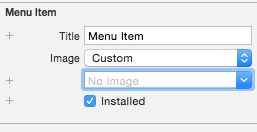AppleWatch开发入门五——菜单控件的使用
AppleWatch开发入门五——菜单控件的使用
一、简介
菜单也是WatchOS中一个重要的交互方式,限于Watch的屏幕尺寸,若将所有用户交互控件都紧密的排列进展示的UI中,那样难免会使用户操作困难,也会影响界面布局的简洁美观。因此,WatchOS的菜单机制是一层覆盖在屏幕上的交互界面,有如下的特点:
1、菜单是内置于InterfaceController中的,不需显式处理,只需对齐菜单项进行添加设置。
2、菜单最多可以容乃四个选项按钮。
3、通过重按可以呼出和隐藏菜单。
二、创建菜单的两种方式
1、通过storyBoard创建
在storyBoard中,我们可以将一个菜单控件拖入到interfaceController中:
在Menu中可以添加一些item,每个item都可以设置图片和文字:
图片的设置分为,自定义和系统两种,我们可以使用自己的图片作为菜单的图片,也可以使用系统为我们提供的一些图片,系统的图片参数是一个枚举,值如下:
public enum WKMenuItemIcon : Int {
case Accept // checkmark
case Add // '+'
case Block // circle w/ slash
case Decline // 'x'
case Info // 'i'
case Maybe // '?'
case More // '...'
case Mute // speaker w/ slash
case Pause // pause button
case Play // play button
case Repeat // looping arrows
case Resume // circular arrow
case Share // share icon
case Shuffle // swapped arrows
case Speaker // speaker icon
case Trash // trash icon
}
这些枚举中提供了一些我们常用的功能图标。
菜单按钮的触发方法,我们可以通过拖拽Action的方式来添加,在Xcode7的模拟器中,我们使用command+shift+2可以切换到重按模式,模拟器效果如下:
2、通过代码来添加菜单选项
前面提到过,菜单是内含于InterfaceController中的一个控件,在Interface中我们可以调用一些方法来添加菜单按钮,相关方法如下:
//添加一个菜单按钮,图片自定义 public func addMenuItemWithImage(image: UIImage, title: String, action: Selector) public func addMenuItemWithImageNamed(imageName: String, title: String, action: Selector) //添加一个系统图片的按钮 public func addMenuItemWithItemIcon(itemIcon: WKMenuItemIcon, title: String, action: Selector) //清除所有按钮 public func clearAllMenuItems()
示例代码如下:
override func awakeWithContext(context: AnyObject?) {
super.awakeWithContext(context)
self.addMenuItemWithItemIcon(WKMenuItemIcon.Share, title: "分享", action:Selector("share"))
self.addMenuItemWithItemIcon(WKMenuItemIcon.Decline, title: "取消", action: Selector("cancle"))
self.addMenuItemWithItemIcon(WKMenuItemIcon.Add, title: "添加", action:Selector("add"))
}
func share(){
print("分享")
}
func add(){
print("add")
}
func cancle(){
}


